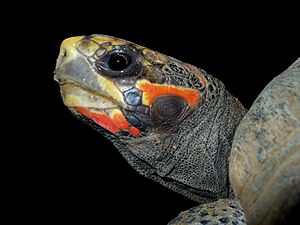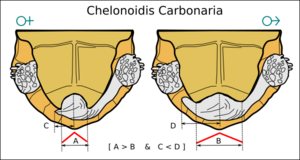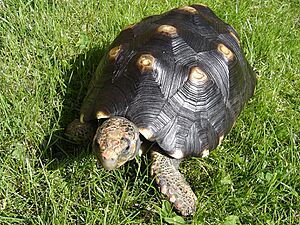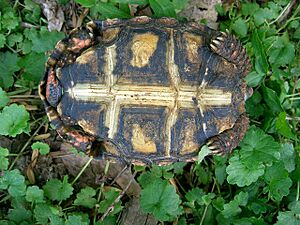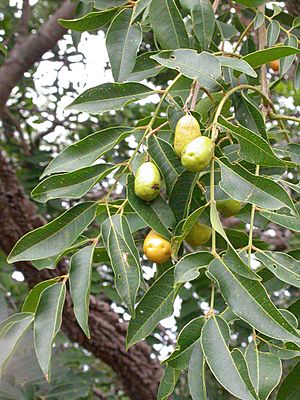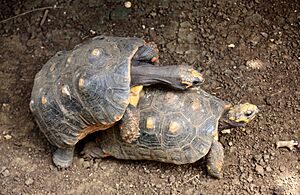Red-footed tortoise facts for kids
Quick facts for kids Red-footed tortoise |
|
|---|---|
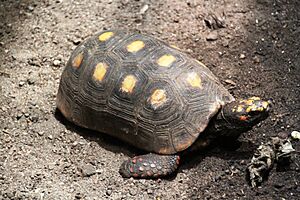 |
|
| Scientific classification | |
| Genus: |
Chelonoidis
|
| Species: |
carbonarius
|
| Synonyms | |
|
|
The red-footed tortoise (Chelonoidis carbonarius) is a cool type of tortoise found in northern South America. These tortoises are medium-sized. They usually grow to about 30 cm (12 in) long. Some can even get bigger than 40 cm (16 in). They have a dark, almost black, top shell called a carapace. Each part of their shell, called a scute, has a lighter spot in the middle. Their bottom shell, the plastron, is also lighter.
Their legs are dark with bright scales. These scales can be pale yellow, bright red, or dark red. This is how they got their name. Red-footed tortoises look a bit different depending on where they live. They are related to the yellow-footed tortoise (C. denticulatus). Yellow-footed tortoises live more to the east in the Amazon Basin.
Red-footed tortoises live in places from savannahs to forest edges near the Amazon Basin. They are omnivorous, meaning they eat both plants and animals. Their diet includes plants, grasses, flowers, and fruits. They also like fungi. Sometimes, they eat earthworms or other small bugs. If they find dead animals, they might eat those too. They do not brumate (like hibernating) because they live near the equator. But they might aestivate (sleep during hot, dry times) when it gets very hot and dry.
Red-footed tortoises are popular pets. Sadly, too many eggs and adult tortoises are taken from the wild. This has made them "vulnerable" to extinction. This means they are at risk, even though it's easy to breed them in captivity. Many people in South America also eat these tortoises. They might not know the tortoises are in danger. Travelers often see them for sale in markets. Young tortoises and eggs are food for many animals. These include caimans, crocodiles, and giant otters. Birds of prey, bushdogs, jaguars, and monkeys also hunt them. Their numbers are shrinking because their homes are being destroyed. Also, too many are collected for food and pets.
The scientific name was often misspelled as carbonaria. This mistake was fixed in 2017. The correct name is carbonarius.
Contents
What Are Their Names?
Red-footed tortoises have many common names. People call them red-leg, red-legged, or red-foot tortoise. Sometimes they are called savanna tortoise. Local names include carumbe or karumbe in Brazil and Paraguay. This name means 'slow moving'. In Venezuela and Colombia, they are called wayapopi or morrocoy. In Brazil and Argentina, they are called jabuti or jabuti-piranga. In Portuguese, jabuti means both red-footed and yellow-footed tortoise. They are also called kati in Natú and sambó in Kiriri.
How Scientists Classify Them
Red-footed tortoises were once put in the group Testudo. This group was named by Carl Linnaeus in 1758. Later, Testudo became the name for all tortoises with high shells and elephant-like legs. In 1835, Leopold Fitzinger used Geochelone for some non-Mediterranean tortoises. He used Chelonoidis as a smaller group for South American species. These names were not used much until the 1930s and 1950s.
In 1982, scientists separated Geochelone into different groups. They looked at differences in their skulls. This created new groups like Aldabrachelys and Chelonoidis. Chelonoidis was for South American tortoises. They also had no neck scute. They had a large, single scute over their tail. Their skulls were also different. Scientists still discuss these names. Chelonoidis is mostly used for tortoises from South America.
The name carbonarius means 'coal-like'. It refers to their dark color with bright patches. Johann Baptist von Spix first described them in 1824. The original tortoise specimen was lost. Some think it came from near Manaus, Brazil. There are no official subspecies of red-footed tortoise. But many believe there are five or more types. These might be subspecies or even different species.
What They Look Like
Red-footed tortoises can look different based on their sex, where they live, and as individuals. This includes their color, shell shape, and small body features. Adult shells are usually long and oval. Their sides are almost straight. But males might have shells that curve inward. Their shells are quite tall and smooth. The scutes (shell plates) can be raised in some tortoises. This is especially true for those kept as pets.
The plates along the center and sides of the shell are black or dark brown. They have a pale yellow spot in the middle. The plates along the edge of the shell tuck under the sides. They flare out a bit over the legs. These are dark with a pale spot along the lower edge. There is no scute over the neck. The plates over the tail are joined as one large piece. You can often see growth rings on their shells. But these wear smooth as the tortoise gets older.
Their plastron (bottom shell) is big and thick. The front plates of the plastron do not stick out much. A male's plastron is deeply curved inward. This helps them during mating. The color pattern on the plastron changes by region.
Their head is quite small and flat on top. It is longer than it is wide. Their eyes are large with dark brown centers. You rarely see the white part of their eye. Their upper jaw is slightly hooked. It has a small notch in the front middle. They have about 15 to 20 fine grooves on each side of their jaws. A round ear drum is behind and below the eye. It is covered with a dark scale. The scales on their head are small and bumpy. Many of these scales are pale yellow to brick red. This is especially true on top of the head, around the nose, and on the neck. Males are usually more colorful than females. Colors also vary by region.
Their legs are generally round. They have five claws on their front legs and four on their back legs. You cannot see their toes. The front legs are a bit flat. The front surface is covered with large, colorful scales. Their tail is strong. Its length and shape differ by sex. It does not have a claw on the tip.
Average adult sizes vary by region and sex. Some "giant" tortoises are found. Red-footed tortoises are usually 30–35 cm (12–14 in) long. Males are a bit larger. Tortoises up to 45 cm (18 in) are common. Some over 50 cm (20 in) are found sometimes. The biggest known one was 60 cm (24 in) long. It weighed over 28 kg (62 lb). This giant was from Paraguay. Scientists are not sure why some get so big.
Baby tortoises have rounder, flatter shells. They start mostly pale yellow to brown. New growth adds dark rings around the pale center of each scute. The edges of very young tortoise shells are jagged. This helps them hide in leaves. It also makes them harder to eat. Young tortoises are usually more colorful.
Males are a bit larger and more colorful. Males from north of the Amazon have a "wasp waist" shell. This means their shell narrows in the middle. A male's plastron is deeply curved inward. This helps him during mating. A male's tail is long and strong. He usually carries it to one side. A female's tail is short and cone-shaped.
The plates near the tail are different for males and females. This allows the male's tail to move more. It also protects the female's back end. In males, the gap between the tail plates and the edge plates is wider. The tail plates form a wider angle, almost a straight line. This lets the tail move sideways. In females, the angle is more closed, about 90 degrees. The points are closer to the edge plates.
Where They Live
Red-footed tortoises live in many places. Their range goes from Panama to Venezuela, Guyana, Suriname, and Guiana in the north. South along the Andes mountains, they are in Colombia, Ecuador, Peru, and Bolivia. To the east, they are in Brazil. In the south, they are in Bolivia, Paraguay, and maybe northern Argentina. They are not found everywhere in these areas. For example, they are not common in central Brazil. They are also not common in very thick forests. They have only been seen in Peru since 1985. It is hard to know their exact range. This is because the area is huge. Also, there are political and geographic barriers. And sometimes, people are confused about where tortoises were found.
They are also found on some Caribbean Islands. It is not always clear if they are native or brought by humans. Many groups of tortoises seem to have been brought in the 1600s. They were used as food or pets. They are found on Trinidad, Tobago, Grenada, Barbados, and other islands.
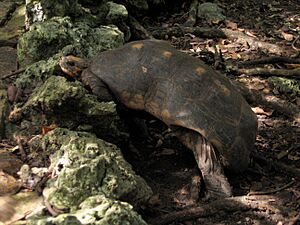
Red-footed tortoises like certain habitats. The temperature is usually around 30 °C (86 °F). It rarely goes below 20 °C (68 °F) or above 35 °C (95 °F). They like high humidity and lots of rain. But some areas can be very dry. Most of their range has a cool wet season (April to August). Then there is a warmer dry season (September to March). But some southern areas can get cold sometimes. Red-footed tortoises are often found where forests meet savannas. This includes forest clearings, forest edges, or near rivers.
Different Types by Region
Scientists have divided red-footed tortoises into different groups. They look at their bodies and where they live. One scientist, Peter Pritchard, found seven types. But DNA studies show five main types.
The biggest differences are between tortoises found north or south of the Amazon River. The "northern" types look like the first described tortoise. They differ mostly in the color of their shell, head, and legs. The types south of the Amazon are usually bigger or smaller. Their plastron pattern is very different. They also have a slightly larger scale on the inside of their front leg elbow.
Northeastern Type
This is the original type of the species. Their head and leg colors are usually light orange to red. Their plastrons are mostly pale yellow. They live in Venezuela, Guyana, Suriname, Guiana, and northern Brazil.
Northwestern Type
These are similar to the northeastern type. But their shell color is grey, dark brown, or coffee, not black. Their pale plastrons have dark spots that look like an exclamation point. Their heads and legs are usually pale yellow to orange. They are a bit smaller than usual, about 30–35 cm (12–14 in). They are found in southeast Panama and Colombia.
Northern Type
These are also similar to the northeastern type. Their head and leg colors are usually pale yellow to light orange. They are rarely red. Their heads and legs often have slightly different colors. They are a bit smaller than usual, about 30–35 cm (12–14 in). They are found in Colombia, Ecuador, and Peru.
Southern Type
The shells of southern types are often dark brown, not quite black. Sometimes they have light grey or whitish areas between the scutes. Their plastrons are mostly dark with a patterned design. They tend to be larger than northeastern types. The biggest tortoises are found here. Their front legs have a slightly larger scale on the side of the "elbow." Adult males do not have the narrow "wasp waist" shell. Females are a bit larger than males. They live in Bolivia, Paraguay, and northern Argentina.
Eastern Type
The shells of eastern types often have light grey or whitish areas between the scutes. Their plastrons are mostly dark with a patterned design. They tend to be smaller than northeastern types. They also become adults at a smaller size. Their front legs have a slightly larger scale on the side of the "elbow." Their heads and legs are either yellowish or red. Some are a bright cherry-red. They live in eastern to southeastern Brazil. The red-headed type is often called a "cherry-head" by pet owners.
How Many Are There?
We do not have much information about how many red-footed tortoises live in the wild. We also do not know the male-to-female ratio. Many tortoises are found near research stations and cities. But this is probably because they are easier to find there. They are thought to be one of the most common turtle species in many places. When a dam was built in Venezuela, hundreds of red- and yellow-footed tortoises were moved. Many are also found in markets or stopped at airports. But very few are recorded from Peru, Ecuador, Argentina, and central Brazil. In some areas, there are many tortoises in one spot, but very few in others.
It is hard to count tortoises. They often hide well, dig into the ground, or go deep into burrows. Special dogs can help find them. One study found about 1.32 males for every female. It also found about 1.05 red-footed tortoises per hectare (2.4 acres) on an island. This might be a low estimate because they are hard to find.
How They Evolved
The Chelonoidis group has two main types. One is the C. carbonarius group, which includes red- and yellow-footed tortoises. They clearly share a common ancestor. The other is the C. chilensis group. This includes the Chaco tortoise (C. chilensis) and Galápagos tortoise (C. niger). They live in similar places and look similar. But they do not seem closely related. The connection between these groups is not clear.
Scientists have theories about why there are few tortoise species in South America. But we do not have many fossils. One old idea is that they came from Asia over a land bridge. Then they spread through North America. They might share ancestors with gopher tortoises. Another idea is that Geochelone ancestors floated from central Africa. Tortoises can float, handle salt water, and go without food for a long time.
DNA studies suggest the carbonarius group might be related to African hingeback tortoises. This means they might have come from Gondwana. Gondwana was a supercontinent that split into Africa and South America about 130 million years ago. One ancient tortoise, Chelonoidis hesterna, lived about 5 million years ago. It might have lived in wet forests. It may have split into two species during the Miocene epoch. Yellow-footed tortoises stayed in deep forests. Red-footed tortoises moved to forest edges and new savannas. As the climate changed, groups of red-footed tortoises became separated. This made them genetically different.
Their Daily Life and Habits
The weather where red-footed tortoises live in the north does not change much. It rarely gets too hot. So, these tortoises do not need to sleep for long periods. They can often look for food all day. One study found them most active after 3:00 pm. Many animals from warmer places are active in the morning and evening. Tortoises from the southern areas have much hotter, colder, and drier weather. They might sleep during hot times when food is scarce. They might also sleep when it gets cold enough.
Most tortoises spend a lot of their day resting. Red-footed tortoises usually rest for over half the daylight hours. They might rest even longer after a big meal. Resting for five to ten days is common. One large tortoise stayed in the same spot for over a month. Resting tortoises barely move. Leaves can pile up on them. Even termites have built tunnels on their shells while they rested.
They look for shelter to stay warm or cool. This also protects them from predators. Fallen trees are a favorite spot. So are piles of debris, burrows, hollow logs, and thick plants. They often try to find tight places to rest. Sometimes they wedge themselves between roots and tree trunks. But they stay exposed otherwise. Burrows and holes often fill with water. The tortoises will rest in the water and mud. Only their nose and eyes stick out. In warmer weather, they press against cooler, wetter surfaces in their shelters. Tortoises have favorite resting spots. Many always go to the same type of shelter.
Shelters are often shared by many tortoises. As many as can fit will use the space. Good shelters are very important. It is hard to see in thick forests. So, tortoises leave scent trails. They or others can follow these trails. Some shelters are used so much that clear paths lead to them. But individual tortoises might not return to the same shelter often.
Red-footed tortoises also show other social behaviors. They do not fight over food. They do not protect their territory. They eat together when fruit falls or when they find dead animals. But sometimes one tortoise might block another from food. Or it might try to take food away. Red-footed tortoises often follow each other. Usually, a smaller one follows a larger one. Males often follow males. But all combinations are seen. They have also been seen following scent trails left a day or two earlier.
Predators
Baby and young tortoises are in great danger from predators. Lizards like tegus, ring-tailed coatis, and introduced rats and mongooses attack nests and eggs. Many predators eat young tortoises. These include large lizards, snakes, crocodiles, and even big turtles. Birds like curassows, guans, and falcons also hunt them. Mammals like cats, opossums, foxes, and wild dogs also eat them.
Besides humans, the main predators of adult tortoises are jaguars. Red-footed and yellow-footed tortoises seem to be an important food source for jaguars. This is true in places like Manú National Park in Peru. Jaguars bite the shell. They try to crack or pry it open to get to the soft parts. Many tortoises have tooth marks from attacks they survived. These marks are often on their back end. This happens when they were partly protected in a burrow.
What They Eat
It is hard to talk about what red-footed tortoises eat. They eat many different foods. The plants available change with the seasons and where they live. Also, what scientists see them eat can be different from what they find in their poop.
Forest tortoises are omnivores. This means they eat both plants and animals. Their upper and lower intestines are about the same length. Tortoises that only eat plants have longer large intestines. This helps them digest tough grasses. Most omnivorous tortoises do not have special digestive parts. This shows they can eat many different things.
Most of their diet is fruit or seed pods. Common fruits come from cacti, figs, and other plants. Up to five different kinds of fruits are often found in their poop. They eat the whole fruit. The seeds pass through and can grow into new plants. This means red-footed tortoises help spread seeds. They have been seen waiting under fruit trees for fruit to fall.
The rest of their diet includes grasses, leaves, flowers, roots, and shoots. They also eat fungi. They eat live bugs like ants, termites, beetles, and worms. They also eat dead animals and animal poop. Tortoises are often found eating dead animals until they are full. Sometimes they eat small live animals like snakes and rodents. Small rocks and sand are also often found in their poop.
Their diet changes with the seasons. In the wet season, it might be 70% fruit. Then 25% fresh leaves and shoots. The rest is fungi and animal food. In the dry season, it is about 40% fruits. Then 23% flowers, and 16% fresh leaves and shoots. The rest is fungi, moss, and animal food.
Omnivorous tortoises look for foods high in calcium. They will even eat mineral-rich soil if they cannot get enough calcium from their food.
How They Move
Red-footed tortoises look for food over large areas. These areas can be from 0.63 to 117.5 hectares (1.6 to 290.3 acres). They usually move in a "spiderweb" pattern. This pattern centers around a good hiding spot or a place where fruit recently fell. They generally move slowly, about 5 to 20 meters per hour. But they can stand on their long legs and move up to 100 meters per hour if they want to go fast. They usually move in zig-zag or looping paths. But sometimes they move 100 m (110 yd) or more in straight lines. They often move quickly then. They really like to move under medium to thick plant cover.
Life Cycle
All turtles and tortoises start as eggs. Red-footed tortoise eggs are round. They are about 5.0 by 4.2 cm (2.0 by 1.7 in) and weigh 50 g (1.8 oz). A female lays two to seven eggs in a nest. But she might lay many nests close to each other. The eggs hatch in 105 to 202 days. About 150 days is typical.
Baby tortoises use a special tooth to open the egg. They stay in the egg or nest for several days. Their shells are bent almost in half inside the egg. It takes some time for them to straighten out. A baby tortoise is about 3.6 by 6.3 cm (1.4 by 2.5 in). Its shell is flat and a bit creased from being folded. It has jagged sides. We do not know much about what wild baby tortoises do or eat each day. Young tortoises grow quickly. They reach breeding size at about 20 to 25 cm (7.9 to 9.8 in). This depends on the average adult size of their regional type.
The best time for mating is the early wet season, in April and May. But it can happen any time. Mating noises and possibly scents seem to attract other tortoises. They gather at "courting sites" under fruit trees. When two tortoises meet about a meter apart, they do special things to identify each other. First, they look at head and leg color. Bright red, orange, yellow, or white colors on dark skin show they are the same species. Then, the bigger tortoise moves its head from side to side for a few seconds. If both tortoises are males, one will leave. Or they might try to ram each other. They try to get their front shell plates under the other one. Then they push them several meters away very quickly. The losing tortoise is sometimes flipped onto its back. The losing tortoise will then leave the area. Head bobbing and fighting have not been seen in tortoises south of the Amazon. This might be because yellow-footed tortoises are not in that area.
The female starts building her nest five to six weeks after mating. Digging nests is often hard in tough soil. The female might pee to soften the soil. Then she uses her back legs to dig a hole about 10 by 20 cm (3.9 by 7.9 in). This takes about three and a half hours. Females who are new to nesting often dig several partial nests. Even experienced females might leave a nest and start another. When the nest is ready, she lowers her tail deep into the nest. She lays an egg every 30 to 120 seconds. She covers the nest and presses the soil down. Females get better at digging, covering, and hiding nests over time. After it is covered and hidden, she often drinks a lot of water. Then she finds a shelter and rests. Very rarely, a red-footed tortoise lays eggs on the surface. Or they might lay them in a patch of cacti.
Like other tortoises, red-footed tortoises can have babies for most of their lives. The number of eggs laid and how many babies hatch successfully gets better as the tortoise gets older. Then it drops as the tortoise ages. It is hard to know the age of a wild tortoise. So, we do not have much information on how long they live. But many live for 30 years or more in captivity.
Protecting Them and How They Interact with Humans
The red-footed tortoise is considered vulnerable. This means they are at risk. They are listed in CITES Appendix II. This limits international trade. But it does not protect them within a country. Smuggling still happens a lot. Conservation parks, breeding farms, and more captive breeding in other countries have helped. But many are still exported (35,565 from 2000 to 2005). Most are sold as pets or for food. The recorded numbers do not include smuggling. Some think the real number is more than twice as high. They are especially at risk in Argentina and Colombia. They are considered more at risk than yellow-footed and Chaco tortoises.
They are widely eaten as food in their home countries. This is especially true where other meats are scarce. They can go a long time without eating. This makes them easy to catch and keeps them fresh. The Catholic Church allows tortoises to be eaten on fasting days. These are days when most meats are not allowed, like Lent. Tortoise pie is a favorite food for these times. Many tortoises are exported just for this. Even people in countries with lots of farm animals enjoy wild game like tortoises. Hunting for food is so common that Colombia and other countries import tortoises from neighbors.
Habitat destruction is another big threat to red-footed tortoises. It affects many other species too. They are also collected as local pets. Their shells are sold as souvenirs.
Caring for Them as Pets
Red-footed tortoises are popular pet tortoises around the world. They are not too expensive. They are a good size to manage. They have interesting personalities and are colorful. Pet tortoises should be bought from a reliable breeder. They should be captive-bred if possible. This helps protect wild populations. It also helps avoid internal parasites.
Any reptile can carry Salmonella bacteria. So, owners should wash their hands after touching the animals or their waste. Dogs, even well-behaved ones, often attack or chew on tortoises. So, be very careful if dogs are around.
Where to Keep Them
All tortoises should be kept outdoors when the weather is good. Outdoor pens should have space for exercise. The walls should be secure and at least 1.5 times taller than the tortoise is long. This protects them from predators and keeps them from escaping. Shelter and water should always be available.
Indoor housing depends on the tortoise's size. It must be secure and waterproof for this species that likes humidity. It also needs enough space. Fish tanks and plastic tubs are often used for younger tortoises. A "tortoise table" (like a bookshelf on its back), an indoor greenhouse, or a large indoor pen can be used for bigger tortoises or groups.
An indoor habitat should have a soft bottom. You can use hardwood mulches (like cypress), coconut coir, or soil and sand mixes. A hiding spot and a water dish are needed. Live or fake plants also help.
Their Environment
Heat, light, and humidity must be correct for healthy tortoises. Red-footed tortoises are most active at temperatures from 27 to 30 °C (81 to 86 °F). A warmer spot of 30 to 31 °C (86 to 88 °F) is good. Night temperatures can drop a few degrees lower. High humidity should be available in some part of their home.
Lighting should not be too bright. Or offer plenty of shade. Lights that give off UVB rays are good. They help the tortoise use calcium correctly. They also help regulate their body if they are indoors for a long time.
What to Feed Them as Pets
Pet tortoises should be allowed to look for food in a well-planted outdoor pen when possible. Their main diet should be a mix of plants, vegetables, and fruits. They can have meat sometimes. The food should be high in calcium and fiber. It should be low in sugars and fats. Fruits should be kept as whole as possible. You can also offer commercial tortoise pellets with fresh foods.
Most of their diet should be leafy greens. These include turnip or collard greens, dandelion, leafy lettuces, endive, kale, and cabbage. Also, edible tree leaves like mulberry or hibiscus, lettuce mixes, parsley, and grape leaves.
Vegetables and fruits add variety and nutrients. But they should be a smaller part of their diet. Good choices are: cactus pads and fruits, papaya, figs, mango, mushrooms, pumpkin, squash, melon, pineapple, strawberry, cucumber, hays and grasses (like wheatgrass), corn, peas and beans, carrot, apple, pear, plums, and okra.
Meats are a very small part of their diet. They can include live bugs (especially slugs), baby mice or rats, chicken, egg, organ meat, lean beef, tuna or other "oily" fish, or cat or dog food.
Calcium should be added often in very small amounts. Other vitamins can also be given in tiny amounts. But it is best to get them from a balanced, varied diet.
|



